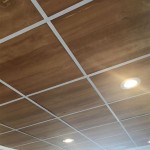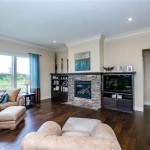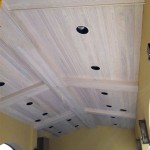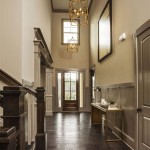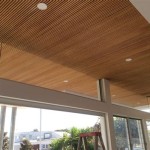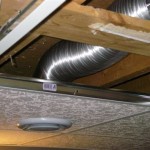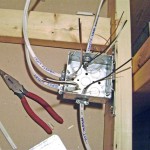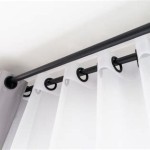Ceiling Design Materials: A Comprehensive Guide
The ceiling, often overlooked in interior design, plays a crucial role in shaping the overall ambiance and aesthetic appeal of a space. From classic drywall to contemporary metal panels, a wide array of ceiling design materials are available, each offering unique characteristics and benefits. Selecting the right material depends on factors such as budget, desired style, and functional requirements. This article explores common ceiling design materials, their characteristics, and applications.
Drywall: The Versatile Standard
Drywall, also known as gypsum board, remains the most popular and versatile ceiling material. Composed of gypsum plaster encased in paper, drywall offers several advantages:
-
Affordability:
Drywall is relatively inexpensive, making it a budget-friendly option for many homeowners. -
Ease of Installation:
Drywall panels are lightweight and easy to install, making them suitable for DIY projects. -
Versatility:
Drywall can be painted, textured, or covered with various finishes to create diverse styles.
-
Painting:
Drywall readily accepts paint, allowing for a wide range of color options. -
Texturing:
Different texturing techniques create unique visual effects, from subtle stippling to dramatic faux finishes. -
Crown Molding:
Crown molding adds elegance and sophistication to a room, enhancing its overall aesthetic appeal.
-
Susceptibility to Moisture:
Drywall is not water-resistant and can be damaged by excessive moisture, making it unsuitable for humid environments. -
Limited Durability:
Drywall is relatively fragile and can be easily damaged by impact.
Wood: Warmth and Elegance
Wood ceilings exude warmth, natural beauty, and a sense of sophistication. Commonly used woods include cedar, oak, pine, redwood, and mahogany, each offering unique characteristics and aesthetic appeal.
-
Warmth and Natural Beauty:
Wood's natural grain patterns and warm tones create a cozy and inviting ambiance. -
Acoustic Properties:
Wood effectively absorbs sound, making it a suitable material for spaces requiring noise reduction.
-
Plank Ceiling:
Horizontal planks create a classic look, enhancing the room's natural charm. -
Beamed Ceiling:
Exposed beams add architectural interest and visual depth to a room. -
Vaulted Ceiling:
Vaulted ceilings create a sense of spaciousness and grandeur.
-
Cost:
Wood ceilings can be more expensive than other options, especially when using exotic or rare woods. -
Maintenance:
Wood requires periodic maintenance, including sanding, staining, or painting, to maintain its beauty. -
Fire Hazard:
Wood is flammable, requiring extra safety precautions, especially in areas with open flames.
Metal Panels: Modern and Durable
Metal ceiling panels offer a modern and sleek aesthetic, ideal for contemporary and industrial designs.
-
Durability:
Metal panels are highly durable, resistant to dents, scratches, and moisture. -
Fire Resistance:
Metal is non-combustible, making it a safe choice for areas with fire hazards. -
Versatility:
Metal panels are available in various finishes, colors, and patterns, providing design flexibility.
-
Aluminum:
Aluminum panels are lightweight, corrosion-resistant, and readily available. -
Steel:
Steel panels are more durable than aluminum and offer higher load-bearing capacity. -
Copper:
Copper panels provide a unique, warm, and rustic appeal, often used in high-end applications.
-
Linear:
Linear panels create a clean and modern look, ideal for minimalist spaces. -
Grid:
Grid panels form a geometric pattern, enhancing the visual interest of the ceiling. -
Tile:
Metal tiles offer a more traditional look, suitable for a variety of design styles.
-
Cost:
Metal panels can be expensive, especially for custom designs and exotic materials. -
Acoustic Considerations:
Metal can be reflective and may require acoustic treatment to manage noise in the space.
Other Ceiling Design Materials
Besides these common materials, other options cater to specific aesthetic preferences and functional needs:
-
Tiled Ceilings:
Tiled ceilings provide a classic and sophisticated look, often using materials like plaster, ceramic, or metal tiles. -
Fabric Ceilings:
Fabric ceilings create a soft and luxurious ambiance, suitable for bedrooms, dining rooms, and other intimate spaces. -
Stretch Ceilings:
Stretch ceilings are a modern option, made from a thin, durable membrane stretched over a frame, offering excellent acoustic properties and seamless integration. -
Acoustic Panels:
Acoustic panels are specialized materials designed to absorb sound, primarily used in spaces requiring noise control, such as recording studios, home theaters, and offices.
Choosing the right ceiling design material is an essential step in creating a functional and aesthetically pleasing space. Each material offers unique characteristics and benefits, allowing homeowners and designers to select the best option to meet their specific needs and preferences. From the versatile drywall to the modern appeal of metal panels, the selection of ceiling design materials provides endless possibilities for transforming a room's overall design and ambiance.

Gyproc Gypsum Ceiling Channels 0 50 Mm At 65 Piece In Vadodara Id 2851878830891

8 Types Of False Ceilings Commonly Used For Home Ultratech Cement

Plastic Ceiling Design Matt Pvc Baffle 20cm 595m Panel Made In China Com

Gyproc Gypsum Ceiling Channels 0 50 Mm At 65 Piece In Vadodara Id 2851878830891

8 Types Of False Ceilings Commonly Used For Home Ultratech Cement

False Ceiling Contractors From 48 Sq Ft Shaj Interior

8 Types Of False Ceilings Commonly Used For Home Ultratech Cement

8 Types Of False Ceilings Commonly Used For Home Ultratech Cement

Latest Design Ceiling Of Techo Pvc Panel False Designs For Hall Made In China Com

False Ceiling Designs You Can Actually Use 72 Rates
Related Posts

